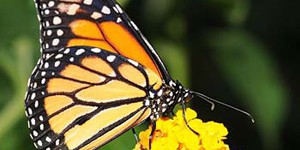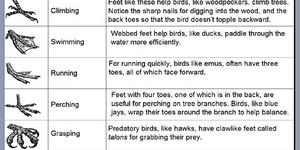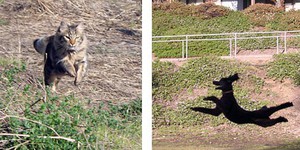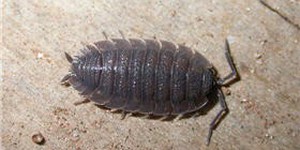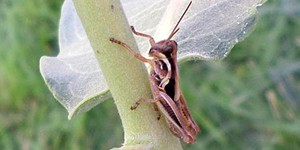Fourth Grade, Zoology Science Projects (14 results)
Animals have developed an amazing variety of body plans, behaviors, and strategies in order to succeed in the struggle for survival. Explore topics ranging from regeneration, camouflage, animal migration, how to attract hummingbirds, and more.
|
Select a resource
Sort by
|
Do you really catch more flies with honey than with vinegar? Do an experiment to find out! Watch the video above to learn how to make a simple homemade fly trap using a plastic bottle. Then, experiment to discover which bait attracts the most flies. You can try a variety of liquids, and you can also use solid bait like rotting food or meat, but you will need to add some water so the flies drown. A drop of soap can help break the surface tension of the water, making it easier for the flies to…
Read more
Featured
Have you heard that garlic powder is supposed to inhibit the growth of bacteria? Which do you think would make a better disinfectant: a solution of garlic powder or a solution of bleach? This project shows you a straightforward way to compare the effectiveness of different disinfectants (or other antimicrobial agents), by measuring zones of inhibition on a culture plate.
Read more
Have you ever seen butterflies fluttering around outside, gliding through the air and landing on flowers? While they are delicate and fragile, butterflies are actually excellent flyers. They are so good, in fact, that scientists at Harvard University studied butterfly wing shapes as an inspiration for building a miniature flying robot. In this science project, you will do your own version of the Harvard scientists' experiment to measure the flight performance of butterfly wings.
Read more
New
If someone asks you to draw a picture of a doctor, lawyer, or engineer, what first pops into your mind? The race and gender of the person you imagine might be shaped by your personal life experiences, such as whether you have family members in those professions, or what representations of them you have seen on TV or online. What do you think will happen if you ask an artificial intelligence (AI) program to generate the picture instead? Will pictures generated by AI reflect the true real-world…
Read more
Animals survive in all sorts of extreme environments, whether it is a polar bear out and about when it is -40°F, a desert iguana trying to find food as the temperature rises to 110°F, or a deep sea anglerfish living 3281 feet down into the sea. How do they do it? The answer is adaptations! Their bodies have special features that allow them to live in those environments. You might not be able to dive down 3281 feet to observe the deep sea anglerfish, but in this science fair project you…
Read more
Ladybugs are common insects in North American gardens that prey upon aphids, making them all the rage in biological pest control. Ladybugs can be bred in captivity making them a good insect to study. Just chop off an aphid infested plant stem for food, make a water soaked cotton ball for water, and add to a small plastic container with a lid to make a breeding box. You can use ladybugs collected from the wild, or buy ladybugs from your local nursery. The most common species is the 12-spotted…
Read more
Do you love animals and want to help keep them healthy? Well, here's your chance to design and tailor a toy that will bring out your pet's most playful nature. In this science fair project, you'll evaluate the skills and activities of your pet and determine what kinds of toys most excite your pet and make him or her lively and curious. So call your furry or feathered friend, and let the frolicking begin!
Read more
New
Artificial intelligence (AI) programs can now generate photorealistic pictures of people who do not exist in the real world. How can you tell if a picture is of a real person or a fake, AI-generated person? What features of the picture do people use to decide whether the face is real or AI-generated? In this project, you will explore these questions as you ask volunteers to look at both real and AI-generated pictures of human faces.
Read more
If you had to choose between having your favorite dessert, going to a movie, or spending the night at a friend's house, which would you choose? This science project shows you how you can "ask" a sowbug (or pillbug) a similar question in order to learn about their preferences. Give it a try to find out what types of microenvironments these tiny crustaceans prefer.
Read more
A cricket as a thermometer? Yes, that is right! In this science fair project, you will investigate how the chirps of these tiny creatures can do more than lull you to sleep—they can tell you the temperature!
Read more
Have you ever wondered how many different types of animals live around your home, like in your backyard or a local park? Animals come in all shapes and sizes, each a small part of the amazing diversity of life. These differences can also help us to classify animals into different groups. One way people classify animals is by their phylum. Do you know which phylum you belong to? In this science project, you will investigate the diversity of the animal life around your home and try to figure out…
Read more
Animals respond to chemical cues in different ways. If an animal turns away from a chemical cue, then that chemical is a repellent. If an animal turns toward a chemical cue, then that chemical is an attractant. Attractants and repellents can be airborne chemicals, chemicals found in food, or chemicals that diffuse through water. One example of an airborne chemical is a pheromone, a chemical signal that is released by one individual to attract another. Moths release pheromones to attract…
Read more
Animals have different levels of activity depending upon their habitat, metabolism and behavior. Diurnal animals are more active during the day. Nocturnal animals are more active at night. Being diurnal or nocturnal may have different advantages for different animals. For example, desert animals tend to be nocturnal so they can stay cool and escape the desert heat present during the day. What types of diurnal and nocturnal animals are common in your area? You can set out a small trap to…
Read more
|
Explore Our Science Videos
How to Build a Paper Speaker
Make an LED Night-Light
Popsicle Stick Catapult





